Mastering Crème Pâtissière: Your Guide to the Ultimate French Pastry Cream
Embark on an exquisite epicurean adventure to France, right from your kitchen, by mastering the art of Crème Pâtissière. At its heart, Crème Pâtissière, often simply called pastry cream, is a sublimely smooth, rich, and highly versatile custard. Crafted from a harmonious blend of humble ingredients—milk, egg yolks, sugar, and starches—this culinary gem is an absolute must-have in any baker’s repertoire. Its simplicity belies its incredible impact, transforming ordinary desserts into extraordinary culinary experiences.
Originating from the sophisticated patisseries of France, Crème Pâtissière has graced countless iconic European desserts for centuries. Its enduring popularity stems not only from its decadent flavor and luxurious texture but also from its remarkable ease of preparation. You might be surprised to learn that achieving this professional-grade pastry cream is a breeze, often taking less than 10 minutes of active cooking time, making it accessible even for novice bakers.
The versatility of Crème Pâtissière knows no bounds. It serves as the quintessential filling for airy cream puffs (choux buns), adds layers of elegance to classic éclairs, and forms the creamy foundation for the majestic mille-feuille, a truly elegant puff pastry dessert. Beyond these traditional French delights, its applications extend far and wide, elevating everyday treats to gourmet status.
Crème Pâtissière truly shines as the star filling in vibrant French fruit tarts, bringing a delightful contrast to fresh berries and glazed fruits. It’s the secret behind the creamy layer in classic cakes like the Boston cream pie and transforms simple doughnuts into decadent indulgences. Furthermore, this foundational custard is the starting point for a myriad of other fantastic creams, including the lighter crème légère, the airy crème diplomat, the gelatin-stabilized crème chiboust, and the buttery crème mousseline.
Excitingly, its rich texture and sweet vanilla notes play a pivotal role in our Festive Sherry Trifle recipe, adding a touch of luxurious indulgence to every spoonful. Don’t let its sophisticated name intimidate you; making proper pastry cream is far easier than you might imagine. With our precise step-by-step guidance and accurate measurements, bakers of all skill levels can confidently create this versatile, creamy custard to elevate their homemade goodies. You’ve got this!

Fast Facts – France: The Cradle of Culinary Excellence

Crème Pâtissière is a testament to France’s rich culinary heritage, a country synonymous with gastronomic innovation and refined techniques. Understanding a little about this beautiful nation enriches our appreciation for its iconic desserts.
| Location | France is strategically located in Western Europe, sharing borders with a diverse array of countries including Belgium, Luxembourg, Germany, Switzerland, Italy, Spain, and Andorra. Its extensive coastlines along the Mediterranean Sea, the Atlantic Ocean, and the English Channel have historically influenced its cuisine and trade, allowing for a rich variety of ingredients to inspire its culinary traditions. |
| Capital | Paris. The “City of Lights” is not only a global center for art and fashion but also the undisputed capital of haute cuisine, where countless pastry shops (patisseries) perfect and showcase delights like Crème Pâtissière. |
| Language | The official language of France is French, a Romance language spoken by millions worldwide and a key component of its rich cultural identity. |
| Population | Home to approximately 67 million people, France boasts a vibrant and diverse population that upholds and evolves its culinary traditions through generations. |
| Culinary Trivia | Time to impress your eco-conscious friends with this fascinating tidbit about France! It’s quite fitting that a nation with such a profound passion for food would lead the way in sustainability. Since 2016, France has made it illegal for supermarkets to discard perfectly edible, unsold food. Instead, it must be donated to charities, a groundbreaking law that reflects a deep respect for food and a commitment to reducing waste. This policy exemplifies a national ethos that values every ingredient, a philosophy perfectly aligned with creating something as exquisite as Crème Pâtissière from simple components. |
Why You’ll Adore This Crème Pâtissière Recipe
Our recipe for Crème Pâtissière is more than just a set of instructions; it’s a gateway to unlocking a world of dessert possibilities. Here’s why this recipe will quickly become a cherished staple in your kitchen:
- Unmatched Versatility: Crème Pâtissière is an incredibly versatile cream, serving as the perfect base for an extensive range of desserts. From delicate cream puffs and flaky tarts to impressive trifles and layered cakes, this single recipe equips you to create a vast repertoire of sweet treats. It adapts beautifully to various textures and flavors, making it indispensable for any baker.
- Effortless Preparation: Forget complicated techniques and lengthy processes. This pastry cream recipe is remarkably straightforward and quick to make, requiring less than 10 minutes of active cooking time. Its simplicity means you can whip up a batch whenever a dessert craving strikes or a special occasion calls for a touch of elegance, without feeling overwhelmed.
- Luxurious Flavor & Texture: Experience the creamy, rich, and intensely flavorful essence of authentic French pastry cream. This recipe delivers a velvety smooth texture that melts in your mouth, infused with classic vanilla notes. It often surpasses the richness of crème anglaise (English custard) in many applications, offering a more stable and decadent filling.
- Customizable Flavor Profile: While vanilla is traditional, this recipe provides a fantastic canvas for experimentation. You can easily adjust the flavor by incorporating a hint of your favorite extracts such as almond, lemon, or even a touch of coffee. This adaptability ensures your pastry cream perfectly complements any dessert theme or personal preference you desire.
- Simple, Everyday Ingredients: Crafted with just seven common, readily available ingredients, you likely already have most of what you need in your pantry. This eliminates the need for special shopping trips, making it a convenient choice for spontaneous baking or last-minute dessert preparations. Quality ingredients combine to create a truly exceptional result.
Key Ingredient Notes and Smart Substitutions for Perfect Pastry Cream
The secret to a truly outstanding Crème Pâtissière lies in understanding the role of each ingredient. Here’s a closer look at what you’ll need and why:
**Please see the complete recipe card at the bottom of this post for precise measurements and the full list of ingredients.
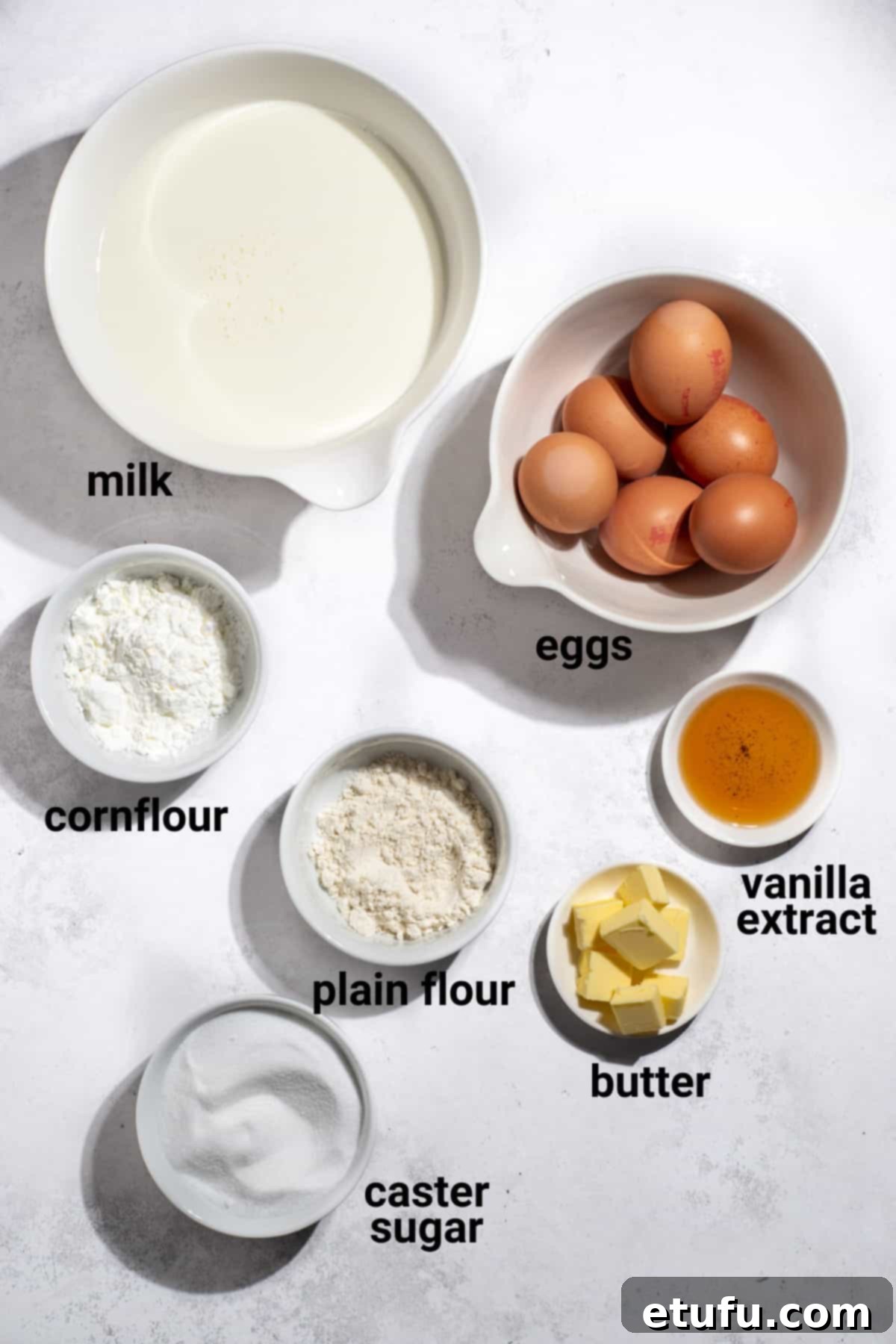
Full-Cream Milk (Whole Milk)
We strongly recommend using whole milk for the best possible results. Its higher fat content is crucial for achieving the desired rich, full-bodied flavor and an exceptionally smooth, creamy texture that defines authentic Crème Pâtissière. Skimmed milk, unfortunately, lacks the depth of flavor and body needed for this pastry cream, often resulting in a thinner, less satisfying product. Conversely, resist the temptation to use heavy cream; while rich, it can cause the mixture to become overly greasy or even separate during cooking, affecting the delicate emulsion.
Starches: The Thickening Powerhouses
Starch is the unsung hero that gives Crème Pâtissière its signature thick, stable consistency. In our carefully formulated recipe, we utilize a combination of plain all-purpose flour and cornstarch (often called cornflour in some regions). This dual-starch approach offers superior thickening power and a smoother finish. Cornstarch contributes to a very smooth, silky texture, while plain flour adds a subtle richness and helps prevent the cream from becoming too jelly-like. The precise balance of these starches ensures your pastry cream sets beautifully without becoming overly stiff or gummy.
Caster Sugar (Superfine Sugar)
Sugar in pastry cream plays a dual role beyond simply adding sweetness. Its fine granules dissolve quickly, ensuring a smooth texture without any grittiness. Crucially, sugar also acts as a protective agent for the egg yolks. It helps to disperse the yolks and prevent them from cooking too quickly and curdling when hot milk is added, effectively tempering the eggs and reducing the risk of scrambled eggs in your custard. While caster sugar is ideal due to its fine texture, it can be successfully replaced with granulated sugar if necessary, though you might need to whisk a little longer to ensure it fully dissolves.
Egg Yolks: For Richness and Color
Egg yolks are indispensable to Crème Pâtissière, providing both intense flavor and essential structure. In this recipe, we specifically use only egg yolks, not whole eggs or just the whites. This is because yolks, with their higher fat content and natural emulsifiers, contribute a significantly richer flavor, a beautiful deep yellow color, and create that characteristic soft, creamy, and velvety texture. The proteins in the yolks also help the cream set as it cools. Don’t let the leftover egg whites go to waste! You can use them to make delightful treats like this beautiful lemon meringue cheesecake, light homemade marshmallow fluff, or crisp meringues.
Vanilla Extract: The Quintessential Flavor
Vanilla reigns supreme as the quintessential flavoring for pastry cream, infusing the custard with its rich, warm aroma and a perfect touch of natural sweetness. For an excellent result, you have a few options: use a good quality vanilla extract for convenience, opt for vanilla bean paste for visible specks and intense flavor, or embark on the indulgent route by using a whole vanilla pod. If using a vanilla pod, simply split it lengthways with a sharp knife and scrape out the tiny, aromatic vanilla seeds. Add both the seeds and the two halves of the pod to the milk as it heats, allowing them to gently infuse their magic, imparting a truly authentic and profound vanilla essence. While vanilla is classic, remember you can explore other delicious flavorings to create unique variations, such as a delicate almond extract or bright citrus zest for a refreshing twist.
Butter: The Finishing Touch for Shine and Silkiness
To put the perfect finishing touches on your Crème Pâtissière, a generous dollop of unsalted butter is whisked into the warm mixture at the very end. This final step is crucial; it not only enhances the custard’s already rich flavor with a subtle buttery note but also gives it a beautiful, glossy shine and an incredibly silky smooth mouthfeel. The butter enriches the cream, adding depth and a luxurious finish that is characteristic of high-quality French pastries. Ensure the butter is cold and added off the heat to prevent it from separating and to achieve maximum silkiness.
How to Make Crème Pâtissière: A Detailed Step-by-Step Guide
Follow these detailed instructions to create flawless Crème Pâtissière every time. Precision and continuous whisking are your keys to success!
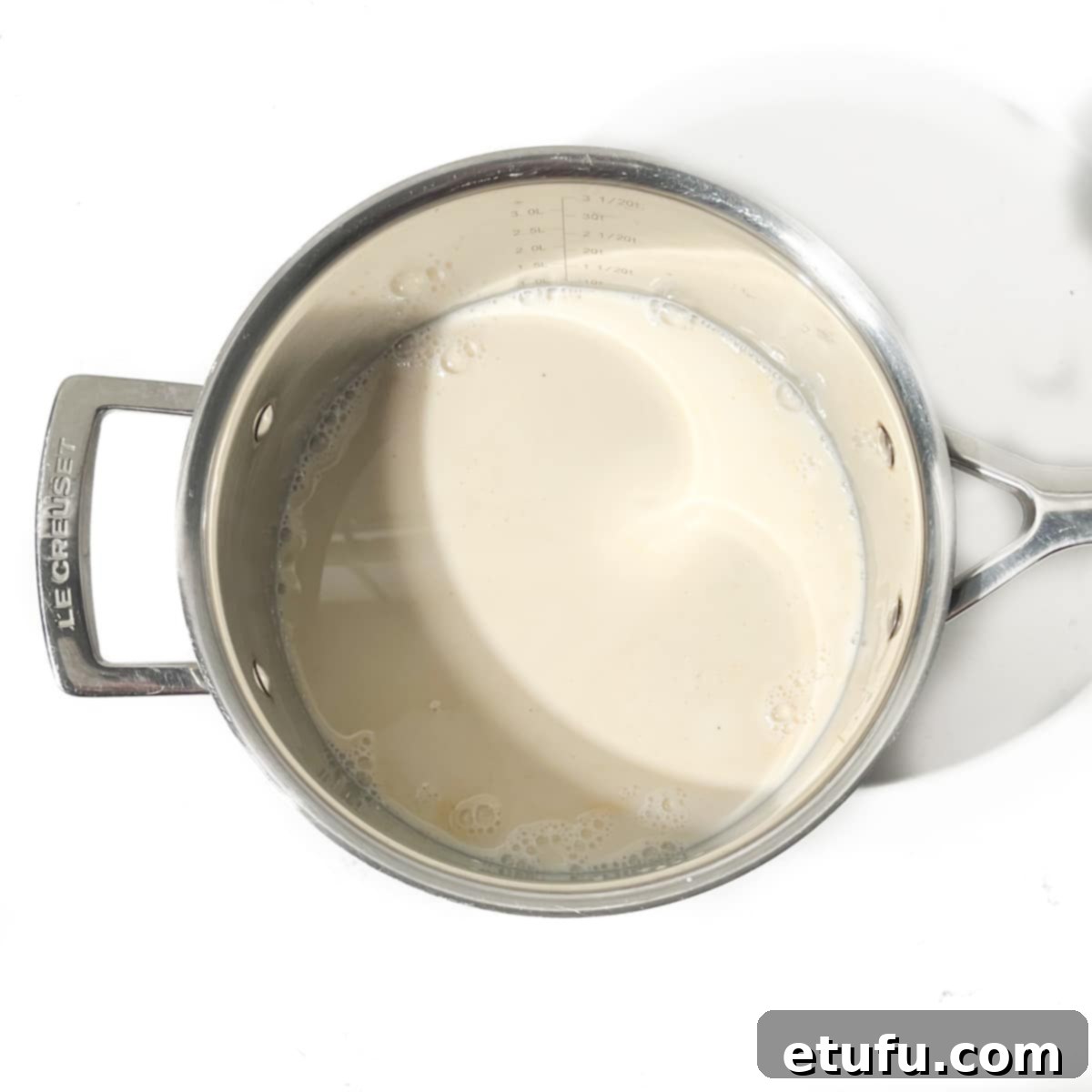
- Prepare the Milk Infusion: In a large, heavy-bottomed saucepan, pour in the full-cream milk. Add your chosen vanilla flavoring—either vanilla extract, vanilla bean paste, or if using a vanilla pod, add both the scraped seeds and the pod halves. This infusion step is essential for a deeply flavored pastry cream.
- Gently Heat the Milk: Place the saucepan over medium-low heat. Slowly and gently bring the milk mixture to a soft simmer. It’s crucial to keep a watchful eye on the milk during this stage. Milk can scorch very quickly, and even the slightest burning at the bottom of the pan can impart an unpleasant, irreversible flavor to your entire pastry cream. Aim for small bubbles around the edges, not a rolling boil.
- Combine Dry and Wet Yolks: While the milk is gently warming, in a separate large mixing bowl, combine the caster sugar, egg yolks, all-purpose flour, and cornstarch.
- Whisk Until Smooth: Using a sturdy wire whisk, vigorously combine these ingredients until they are thoroughly mixed into a smooth, pale yellow paste. Ensure there are no lumps of flour or cornstarch remaining, as this will lead to a grainy texture in your finished cream. The mixture should be thick and uniform.
- Remove Milk from Heat: Once the milk reaches a gentle simmer, with steam rising and small bubbles forming around the edges, promptly remove it from the heat. If you used a vanilla pod, remove the pod halves at this point.
- Temper the Egg Mixture: This is a critical step called tempering. Carefully and slowly pour about one-third of the hot milk into the egg yolk mixture while continuously whisking vigorously. The goal is to gradually raise the temperature of the egg yolks without scrambling them. Keep whisking until the mixture is smooth and well combined.
- Combine All Ingredients: Now, pour the tempered egg mixture back into the saucepan containing the remaining milk. Give it a thorough whisk to ensure all ingredients are perfectly combined and integrated.
- Return to Heat and Thicken: Place the saucepan back on the stove over medium-low heat. Continue to whisk continuously and vigorously as you slowly bring the mixture to a gentle boil. This continuous whisking is vital to prevent lumps and ensure even cooking and thickening.
- Cook the Starches and Eggs: Once the mixture reaches a gentle boil and visibly begins to thicken, reduce the heat to low. Continue whisking vigorously for an additional 2 minutes from this boiling point. This crucial step allows the flour and eggs to fully cook out, preventing any raw starch flavor and ensuring a stable, smooth cream. Maintain a steady, gentle ‘slow bubble’—not too slow where it stops cooking, and not too fast where it burns. You’ll feel the resistance of the whisk as it thickens.
- Incorporate the Butter: After precisely 2 minutes of cooking and vigorous whisking, remove the pastry cream from the heat. Immediately add the cold butter, cut into small pieces.
- Achieve Silkiness and Shine: Whisk vigorously once more until the butter is completely melted and fully incorporated. The pastry cream will transform into a beautifully smooth, creamy, and glossy consistency, signaling its perfection.
- Cooling and Preventing a Skin: Transfer the hot pastry cream immediately to a clean bowl. To prevent a tough skin from forming on the surface as it cools, firmly press a piece of plastic wrap directly onto the surface of the cream, ensuring no air pockets remain. Allow it to cool down completely to room temperature before placing the bowl in the fridge to chill thoroughly until you are ready to use it. Chilling for at least 2-3 hours is recommended for optimal texture.
- Ready for Use: Before using your chilled pastry cream, give it a thorough whisk again. This re-incorporates any liquid that may have separated and makes it smooth, light, and easy to pipe or spread. If you find the cream a bit too thick for a particular application, such as layering in a trifle, you can add a splash of cold milk or cream (1-2 tablespoons at a time) and whisk it in until it reaches your desired, spreadable consistency.
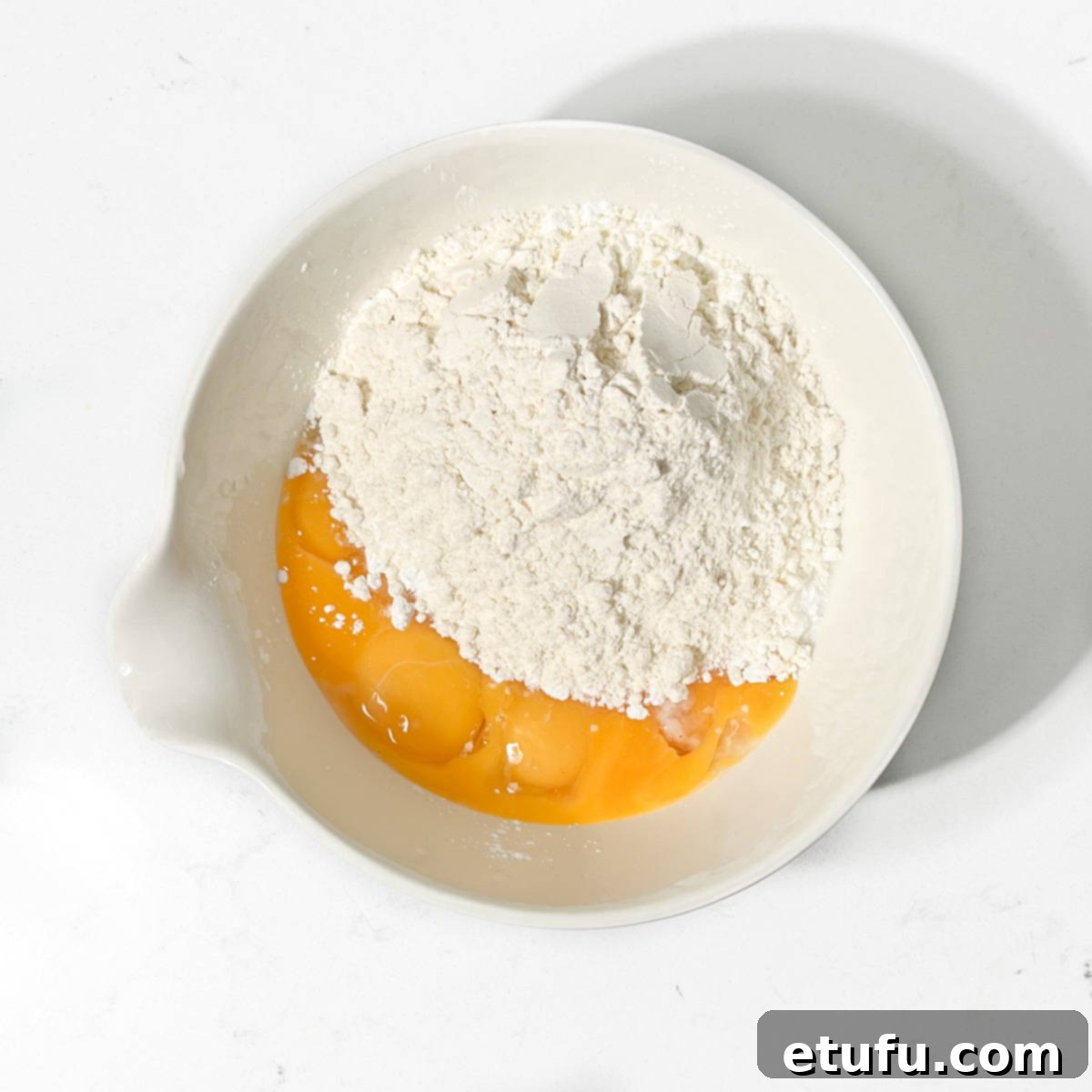
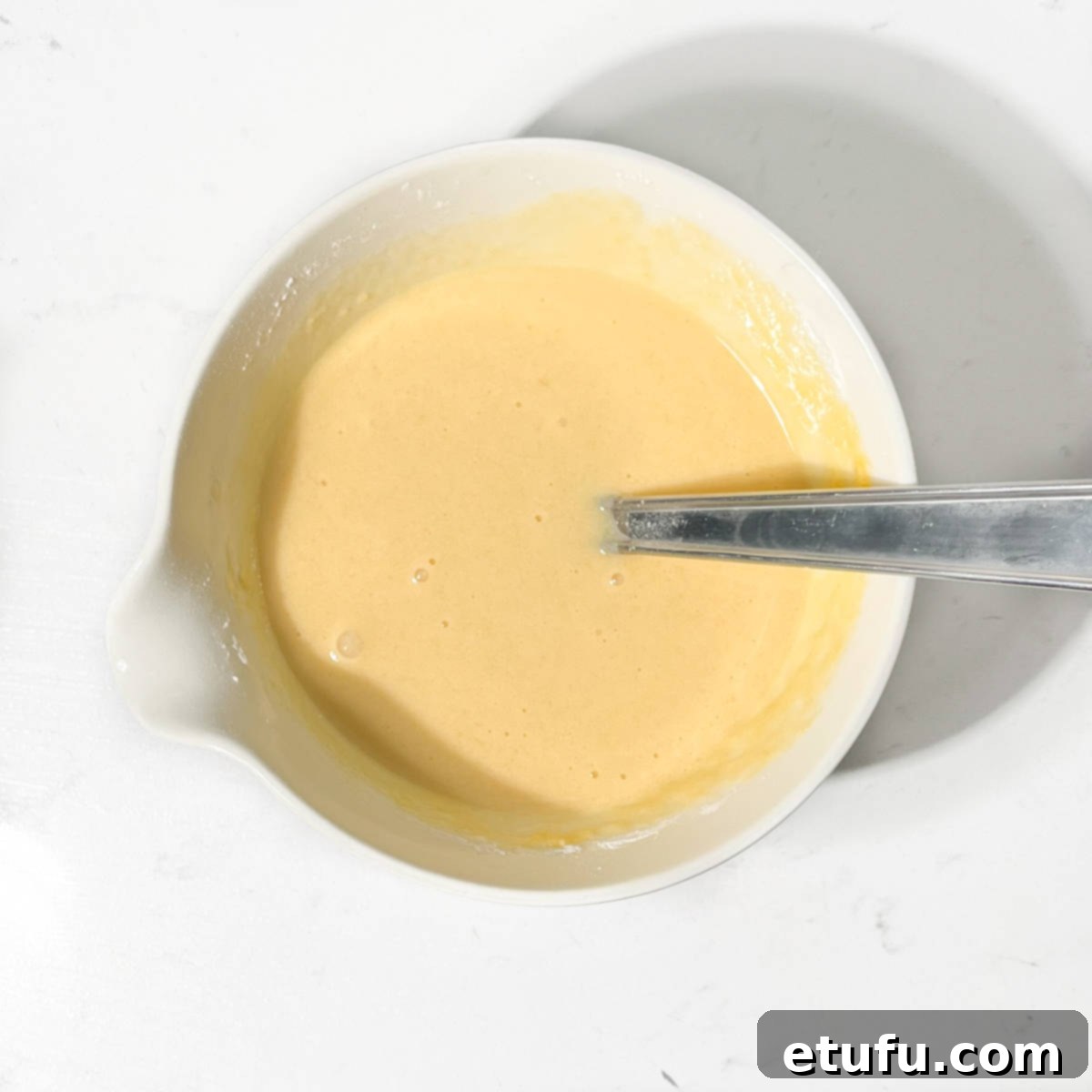
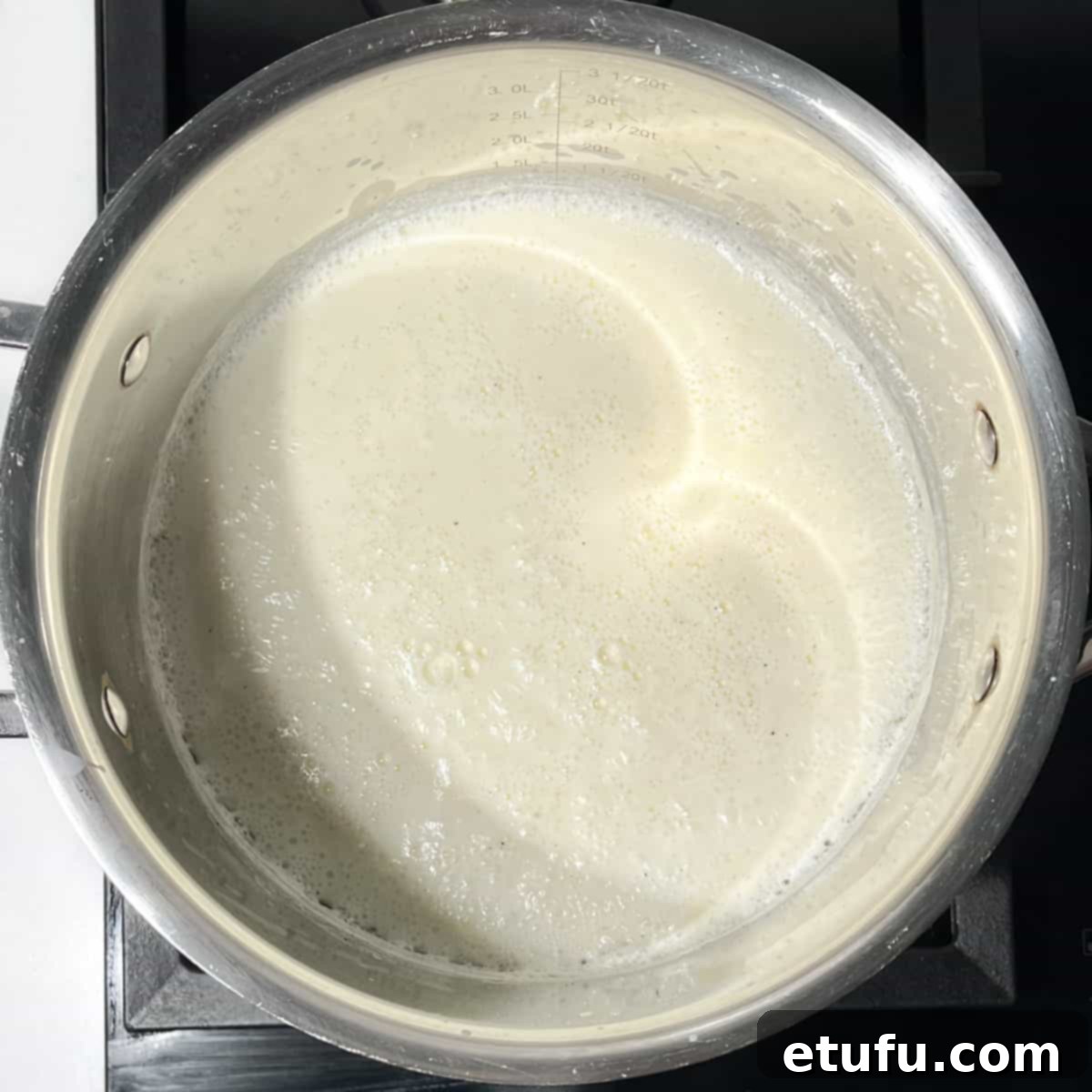

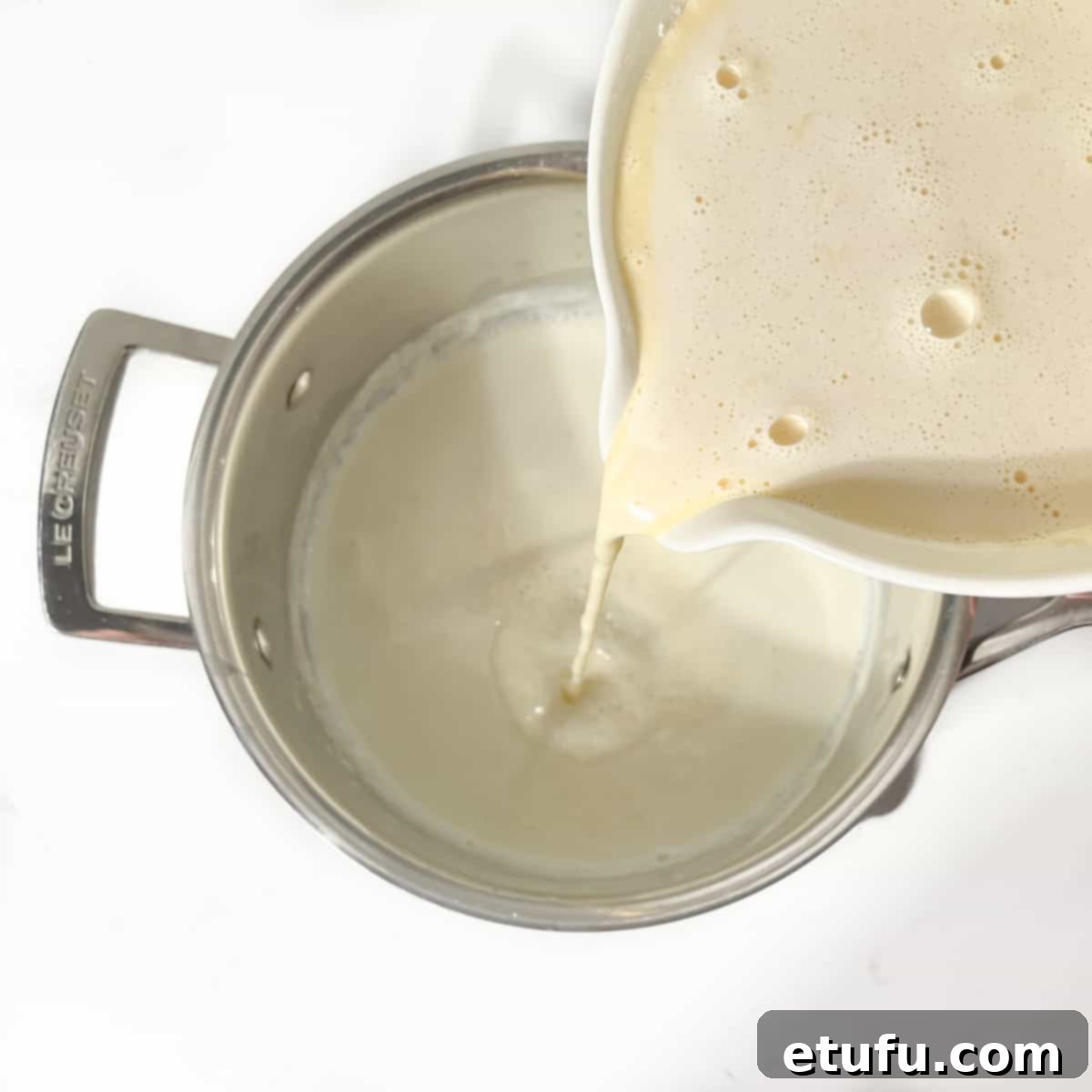
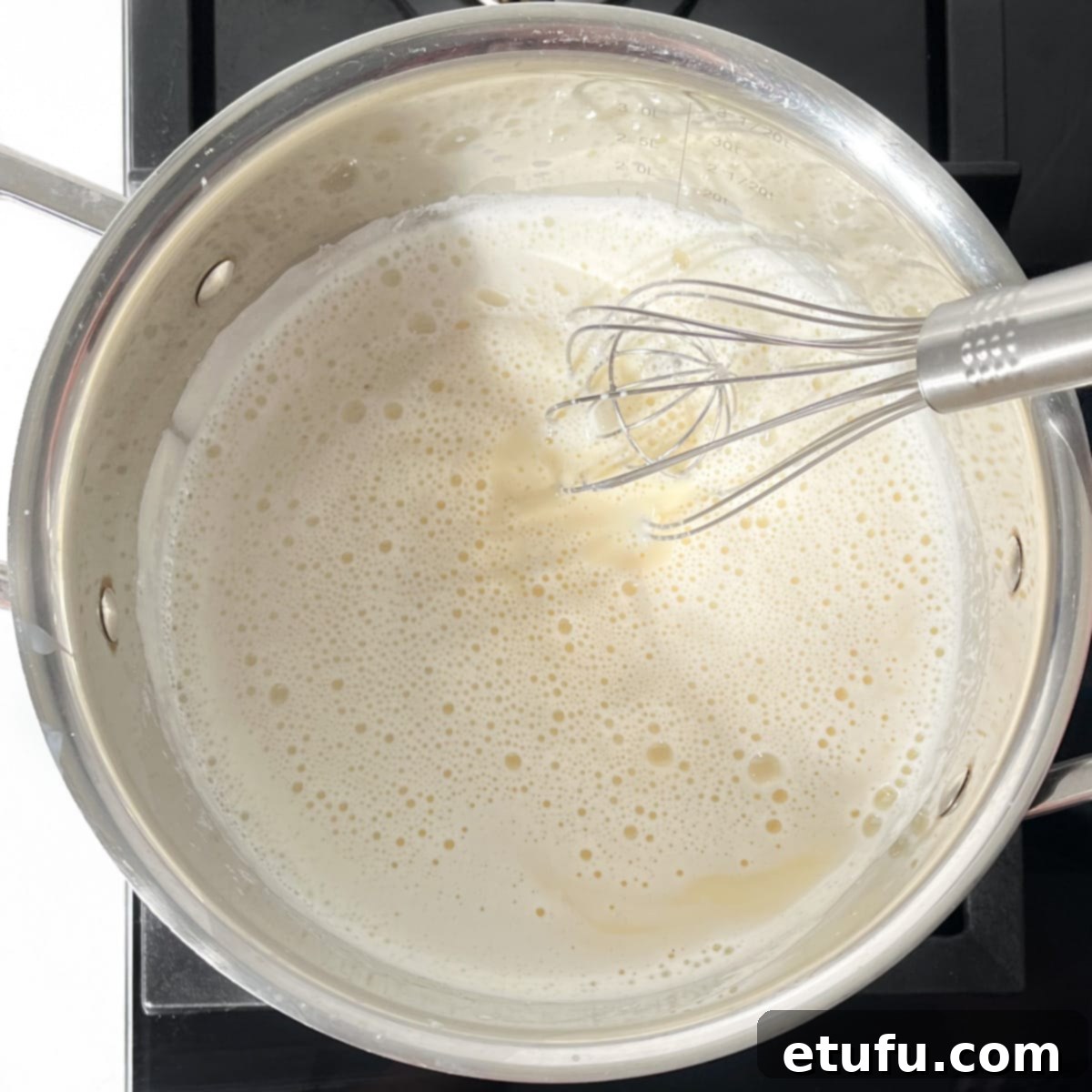

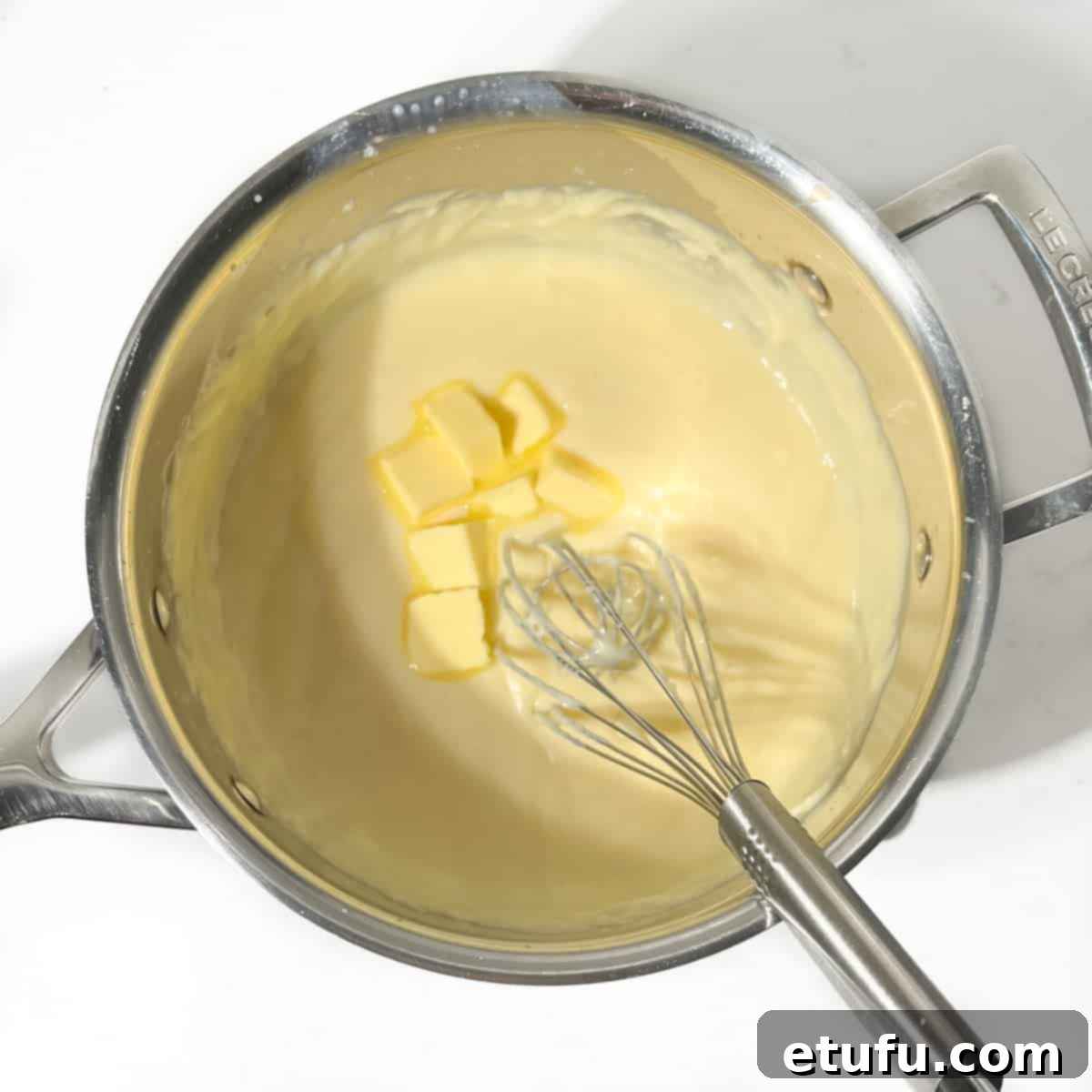
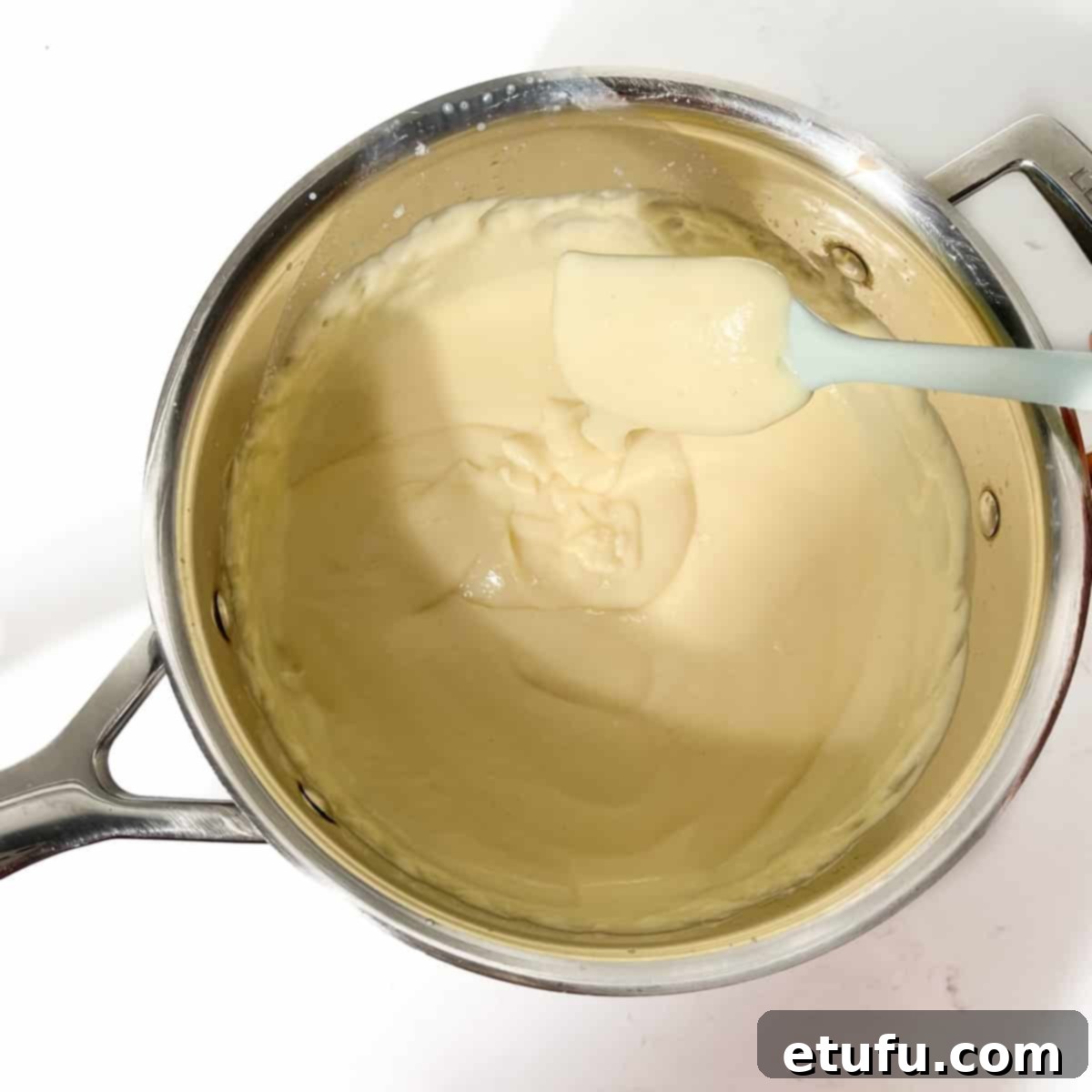
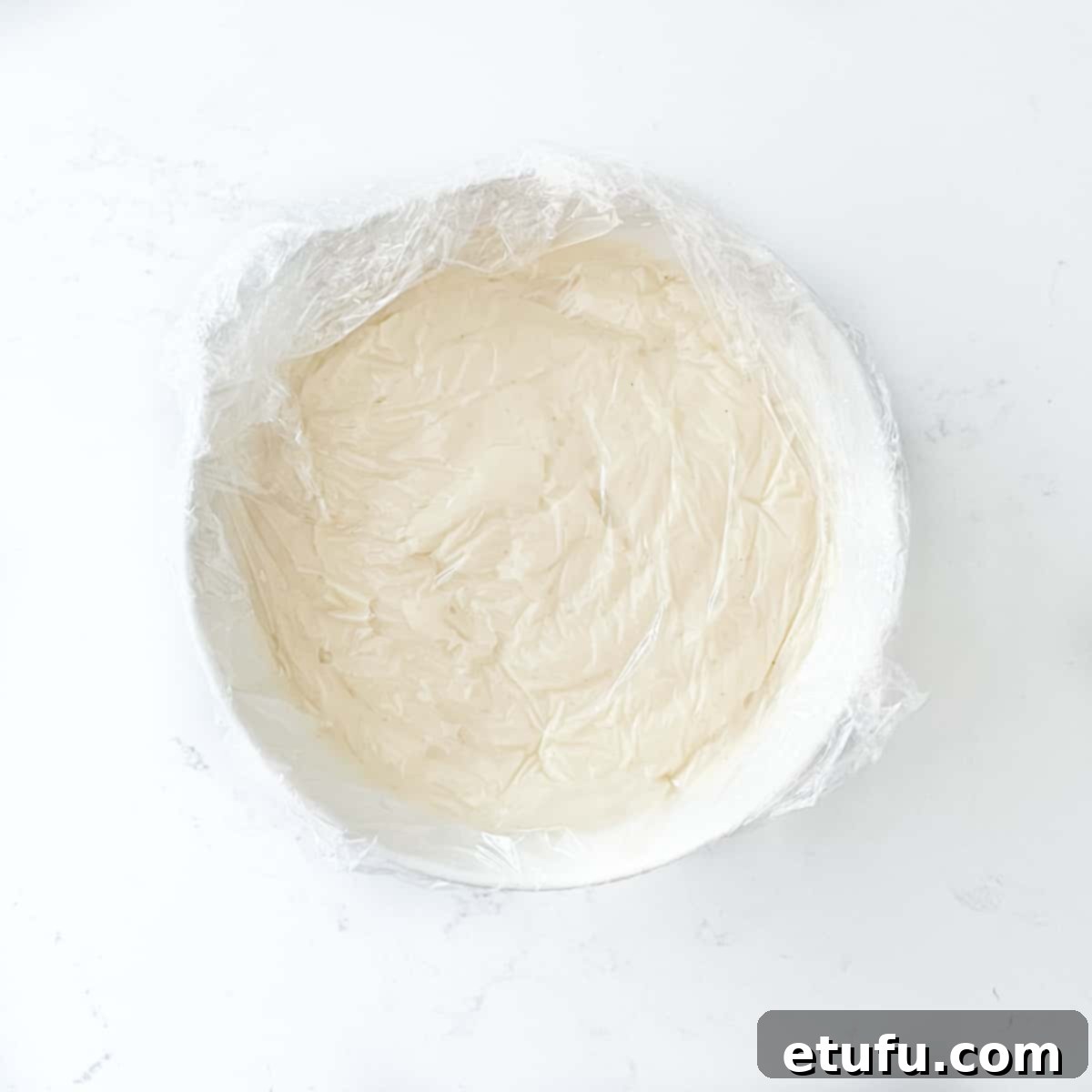
Expert Tips for Crème Pâtissière Perfection
Achieving consistently perfect Crème Pâtissière is simpler with these expert tips:
Never Stop Whisking
Diligent and continuous whisking is absolutely vital throughout the entire cooking process. It guarantees that the pastry cream thickens uniformly, preventing lumps from forming, and minimizes the risk of scorching or burning spots at the bottom of the saucepan. Always use a proper wire whisk; a fork or a spoon simply won’t provide the necessary aeration and mixing power. Avoid distractions, such as checking your phone or multitasking in the kitchen, as a momentary lapse can lead to a less-than-perfect cream.
Maintain a Gentle Bubble
After the mixture has thickened to a visible boil, it’s crucial to reduce the heat to low and maintain that gentle, consistent ‘slow bubble’ for the final two minutes of cooking. If the heat is too low, the starches and eggs won’t fully cook, potentially leading to an undesirable raw flavor or texture problems. If the heat is too high, the pastry cream could burn quickly, or the eggs might curdle. The “sweet spot” is a consistent, gentle ‘plop…plop…’ effect. Pause your whisking for just a second to observe this gentle bubbling—it indicates that the cream is cooking at the correct pace.
Use a Heavy-Bottomed Pan
A heavy-bottomed saucepan distributes heat more evenly, significantly reducing the risk of your milk scorching or your pastry cream sticking and burning to the bottom. This is a small investment that yields big results in delicate custard making.
Strain for Ultimate Smoothness (Optional but Recommended)
For a truly professional, silky-smooth Crème Pâtissière, consider passing the freshly cooked cream through a fine-mesh sieve immediately after adding the butter. This step will catch any tiny lumps that might have formed, ensuring an impeccably smooth final product. While not strictly necessary if you’ve whisked diligently, it’s a foolproof way to guarantee perfection.
Creative Variations for Your Crème Pâtissière
Crème Pâtissière is a versatile canvas, ready to be infused with an array of flavors. Experiment with these ideas to create unique dessert experiences:
- Decadent Chocolate Pastry Cream: For a rich chocolate version, simply incorporate good quality dark, milk, or white chocolate into the warm pastry cream immediately after removing it from the heat and adding the butter. Whisk until the chocolate is fully melted and smoothly combined, creating a luxurious chocolate custard perfect for éclairs or cake fillings.
- Nut Butter & Spread Infusions: Once the pastry cream has completely cooled down, whisk in creamy pastes like Nutella, Biscoff spread, or even a smooth peanut butter. It’s crucial to add these after cooling to prevent them from interfering with the setting process of the warm cream, ensuring a stable and richly flavored custard.
- Bright Citrus Zest: Infuse your pastry cream with a vibrant and refreshing flavor by adding finely grated zest from citrus fruits like oranges, lemons, or limes to the milk as it heats. The oils from the zest will impart a beautiful, aromatic freshness.
- Fruity Puree Blends: Blend in smooth fruit purees such as raspberry, passion fruit, or mango for a naturally vibrant and tangy twist. Ensure the puree is smooth and relatively thick to avoid altering the consistency of the pastry cream too much. These are best folded into the cooled cream.
- Coffee or Espresso Infusion: For coffee lovers, mix in a teaspoon or two of instant espresso powder or a shot of strong espresso (cooled) to the milk as it heats. This creates a coffee-flavored custard that pairs wonderfully with chocolate cakes, tiramisu-inspired desserts, or coffee-infused pastries.
- Warm Spiced Custard: Experiment with warm spices like cinnamon, cardamom, or nutmeg by infusing them into the milk. These spices add a cozy depth and complexity, perfect for autumn or holiday-themed desserts, like spiced apple tarts or pumpkin-filled pastries.
- Sophisticated Liqueur Infusion: For an adult twist, a splash of your favorite liqueur such as Grand Marnier (orange), Amaretto (almond), Kahlúa (coffee), or rum can provide a sophisticated and aromatic flavor to your pastry cream. Add it after the cream has cooled slightly, usually at the same time as the butter, to retain its alcoholic notes and flavor.
Endless Applications: Where Crème Pâtissière Shines
The versatility of Crème Pâtissière makes it an indispensable component in a vast array of sweet creations. Here are some of the most popular and delightful uses for this exquisite French custard:
- Crème Légère: Combine pastry cream with whipped cream for a lighter, airier, yet still rich filling. Ideal for delicate cakes and fruit tarts.
- Crème Diplomat: Similar to crème légère, this involves folding in gelatin-stabilized whipped cream into pastry cream for a supremely light and stable filling, perfect for intricate layered desserts.
- Crème Chiboust: A classic French cream made by folding meringue into warm Crème Pâtissière, resulting in a cloud-like, stable, and airy cream often used for St. Honoré cake.
- Crème Mousseline: A richer version, made by beating soft butter into cooled Crème Pâtissière, yielding a velvety, pipeable cream perfect for Paris-Brest or opera cakes.
- Choux Pastries: The classic filling for light and airy choux buns, profiteroles, and éclairs, providing a creamy contrast to the crisp pastry.
- Éclairs: Long, elegant pastry filled with rich Crème Pâtissière and often topped with chocolate glaze.
- Mille-Feuille (Napoleon): Layers of crisp puff pastry alternated with smooth pastry cream, creating a delightful textural contrast.
- Fruit Tarts: The creamy base for fresh fruit tarts, providing a sweet foundation that complements the tartness of berries and other fruits. (French Fruit Tart)
- Filling for Cakes: Excellent as a filling between cake layers for a rich, moist, and flavorful addition to any celebration cake, such as a classic Boston cream pie.
- Profiteroles: Small choux pastry balls filled with pastry cream and often drizzled with chocolate sauce.
- Danish Pastries: A delightful filling for various Danish pastries, adding a custardy sweetness.
- Custard Buns: Sweet bread buns filled with creamy Crème Pâtissière.
- Doughnuts: Elevate homemade or store-bought doughnuts with a luscious Crème Pâtissière filling.
- Cream Puffs: The quintessential filling for these classic French treats.
- Filled Croissants: A wonderful addition to plain croissants, transforming them into a more decadent breakfast or dessert item.
- Parfaits: Layered with fruits, granola, or cake pieces for a beautiful and delicious dessert in a glass.
- Trifles: Adds a luxurious, creamy layer to traditional trifles, soaking up fruit juices and complementing sponge cake. (Festive Sherry Trifle)
- Filled Pancakes or Crêpes: Spread or pipe onto pancakes or thin crêpes for an elegant breakfast or dessert.
- Cannoli: While traditionally filled with ricotta, a vanilla Crème Pâtissière can offer a delightful, creamy alternative.
- Waffles: A decadent topping or filling for freshly made waffles, especially when paired with fresh fruit.
Storage Solutions for Your Crème Pâtissière
Proper storage is essential to maintain the freshness and quality of your homemade pastry cream. Once cooled, transfer your Crème Pâtissière to an airtight container. To prevent a tough skin from forming on the surface and to keep it fresh, gently press a piece of plastic wrap or buttered parchment paper directly onto the surface of the cream, ensuring it makes full contact and no air is trapped. Store it in the refrigerator, and it will remain fresh and delicious for up to 3 days. It’s important to note that Crème Pâtissière is not suitable for freezing. Freezing and thawing can cause the emulsion to break, resulting in a grainy or watery texture that is undesirable.
Delightful Pairings for Crème Pâtissière
Crème Pâtissière’s rich and creamy texture makes it a perfect companion for a variety of desserts:
Jam and Coconut Sponge (a fantastic alternative to traditional custard)
Crispy-Edged Danish Pancakes (Pandekager)
Tarte aux Fruits (French Fruit Tart)
Hot Cross Bun Bread and Butter Pudding (an indulgent twist when replacing regular custard)
Explore More Dessert Toppings and Fillings
If you love creating your own dessert components, consider these other delicious recipes:
Homemade Marshmallow Fluff without Corn Syrup
Decadent Mascarpone Whipped Cream
Crème Pâtissière Recipe (Classic Vanilla Pastry Cream)
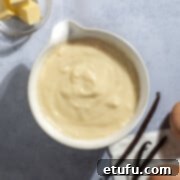
Crème Pâtissière Recipe (Vanilla Pastry Cream)
Crème Pâtissière, or French pastry cream, is a sublimely smooth and versatile custard made from milk, egg yolks, sugar, and starches. This essential culinary foundation is a must-have for any baker, offering a multitude of uses in classic desserts. Best of all, it’s incredibly quick and easy to make, taking less than 10 minutes of active preparation time!
Equipment
- 1 large saucepan
- 1 large bowl
- 1 wire whisk
Ingredients
- 500 ml full cream milk
- 2 teaspoons vanilla extract – (or one vanilla pod, split lengthways and seeds scraped)
- 100 grams caster sugar
- 6 egg yolks
- 2.5 tablespoons plain flour – (or 20g)
- 2.5 tablespoons cornstarch – (or 20g)
- 1 tablespoon butter (heaped) – (or 20g)
Instructions
- In a large saucepan, pour in the milk and the vanilla extract (or any other flavorings you prefer).
- Using medium-low heat, slowly bring the milk to a gentle simmer. Be sure to keep a watchful eye on it. Milk can burn swiftly, and even the slightest scorch can negatively impact the flavor of your pastry cream.
- As the milk is gradually warming up, place the sugar, egg yolks, all-purpose flour, and cornstarch into a large bowl.
- Whisk the ingredients together thoroughly until they are well combined with no lumps.
- Check on the milk. As soon as it reaches a gentle simmer, remove it from the heat.
- Carefully pour about one-third of the hot milk into the egg mixture and quickly whisk it together. This process is called tempering.
- Next, pour the tempered egg mixture back into the saucepan with the remaining milk and give it a thorough whisk to combine all the ingredients.
- Put the saucepan back on the stove over medium-low heat and slowly bring it to a gentle boil, making sure to whisk continuously.
- Once the mixture has reached a gentle boil and begins to thicken, reduce the heat to low. Continue whisking vigorously for an additional 2 minutes from boiling point to allow the flour and eggs to cook. Maintain a steady, gentle, ‘slow bubble’ – not too slow and not too fast.
- After the 2 minutes, remove the pastry cream from the heat and add the butter.
- Whisk vigorously until the pastry cream becomes smooth, creamy, and shiny.
- Transfer the pastry cream to a clean bowl and cover the surface with a piece of plastic wrap to prevent a skin from forming. Let it cool down before placing the bowl in the fridge until you’re ready to use it.
- When you’re ready to use the pastry cream, give it a thorough whisk to make it smoother. If you need it to be a bit thinner, especially for something like a trifle, you can add a splash of milk or cream and whisk it in until it reaches your desired consistency.
Notes
Don’t Stop Whisking
Diligent whisking is vital as it guarantees that the pastry cream thickens uniformly and minimizes the risk of lumps or burnt spots. Use a wire whisk and not a fork or a spoon. Avoid distractions, such as checking your phone or multitasking in the kitchen.
Keep It Bubbling
After the mixture has thickened, be sure to maintain that gentle, consistent ‘slow bubble’. If it’s too low, you might encounter texture problems, and if it’s too high, the pastry cream could burn. Pause the whisking for a second and see if you notice the slow ‘plop…plop…’ effect. That’s the sweet spot.
**Nutritional Data Disclaimer**
Please keep in mind that the nutritional information provided below is calculated by a third party and we cannot guarantee its complete accuracy. We strive to offer the most accurate information possible, but we do not take responsibility for potential errors. Also, the nutritional value of the recipe may vary depending on the exact brands and products used. We recommend consulting with a qualified healthcare professional or registered dietitian for personalized advice on your dietary needs.
Nutrition (Per Serving)
Calories: 219kcal | Carbohydrates: 27g | Protein: 6g | Fat: 10g | Saturated Fat: 5g | Polyunsaturated Fat: 1g | Monounsaturated Fat: 3g | Trans Fat: 0.1g | Cholesterol: 210mg | Sodium: 57mg | Potassium: 155mg | Fiber: 0.1g | Sugar: 21g | Vitamin A: 458IU | Calcium: 130mg | Iron: 1mg
For food safety advice, including guidance on food allergies
